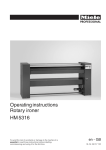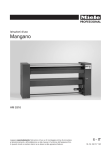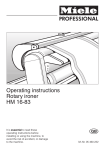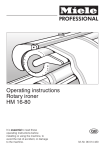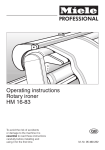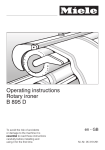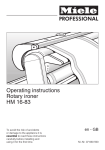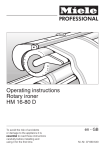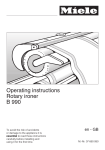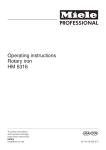Download Miele MM 50-175 Operating instructions
Transcript
Operating instructions Rotary ironer MM 50-175 MM 50-205 To avoid the risk of accidents or damage to the machine it is essential to read these instructions before it is installed, commissioned and used for the first time. G M.-Nr. 05 567 240 /03 2 M.-Nr. 05 567 240 /03 Contents Warning and Safety instructions . . . . . . . . . . . . . . . . . . . . . . . . . . . . . . . . . . . . . . . . . . . . . . . 4 Caring for the environment . . . . . . . . . . . . . . . . . . . . . . . . . . . . . . . . . . . . . . . . . . . . . . . . . . . . 6 Description of the machine . . . . . . . . . . . . . . . . . . . . . . . . . . . . . . . . . . . . . . . . . . . . . . . . . . . . 7 Safety features . . . . . . . . . . . . . . . . . . . . . . . . . . . . . . . . . . . . . . . . . . . . . . . . . . . . . . . . . . . . . . 9 Finger guard. . . . . . . . . . . . . . . . . . . . . . . . . . . . . . . . . . . . . . . . . . . . . . . . . . . . . . . . . . . . . . . . . 9 Emergency stop switch . . . . . . . . . . . . . . . . . . . . . . . . . . . . . . . . . . . . . . . . . . . . . . . . . . . . . . . . 9 Emergency release during a power cut . . . . . . . . . . . . . . . . . . . . . . . . . . . . . . . . . . . . . . . . . . . 10 Preparing the laundry . . . . . . . . . . . . . . . . . . . . . . . . . . . . . . . . . . . . . . . . . . . . . . . . . . . . . . . 11 Condition of linen . . . . . . . . . . . . . . . . . . . . . . . . . . . . . . . . . . . . . . . . . . . . . . . . . . . . . . . . . . . . 11 Preparing the flatwork . . . . . . . . . . . . . . . . . . . . . . . . . . . . . . . . . . . . . . . . . . . . . . . . . . . . . . . . 11 Ironing . . . . . . . . . . . . . . . . . . . . . . . . . . . . . . . . . . . . . . . . . . . . . . . . . . . . . . . . . . . . . . . . . . . . 12 Baffle – exhaust ducting. . . . . . . . . . . . . . . . . . . . . . . . . . . . . . . . . . . . . . . . . . . . . . . . . . . . . . . 13 Pick-off bands . . . . . . . . . . . . . . . . . . . . . . . . . . . . . . . . . . . . . . . . . . . . . . . . . . . . . . . . . . . . . . 13 Variations in equipment . . . . . . . . . . . . . . . . . . . . . . . . . . . . . . . . . . . . . . . . . . . . . . . . . . . . . . 14 Foot control bar . . . . . . . . . . . . . . . . . . . . . . . . . . . . . . . . . . . . . . . . . . . . . . . . . . . . . . . . . . . . . 14 Lid . . . . . . . . . . . . . . . . . . . . . . . . . . . . . . . . . . . . . . . . . . . . . . . . . . . . . . . . . . . . . . . . . . . . . . . 14 Laundry return feed . . . . . . . . . . . . . . . . . . . . . . . . . . . . . . . . . . . . . . . . . . . . . . . . . . . . . . . . . . 14 Important notes . . . . . . . . . . . . . . . . . . . . . . . . . . . . . . . . . . . . . . . . . . . . . . . . . . . . . . . . . . . . 16 Power cut during ironing . . . . . . . . . . . . . . . . . . . . . . . . . . . . . . . . . . . . . . . . . . . . . . . . . . . . . . 16 Motor protection . . . . . . . . . . . . . . . . . . . . . . . . . . . . . . . . . . . . . . . . . . . . . . . . . . . . . . . . . . . . . 16 Feed-in table adjustment range . . . . . . . . . . . . . . . . . . . . . . . . . . . . . . . . . . . . . . . . . . . . . . . . . 16 Cleaning and care . . . . . . . . . . . . . . . . . . . . . . . . . . . . . . . . . . . . . . . . . . . . . . . . . . . . . . . . . . 17 Waxing the heater plate . . . . . . . . . . . . . . . . . . . . . . . . . . . . . . . . . . . . . . . . . . . . . . . . . . . . . . . 17 Care of the aluminium heater plate . . . . . . . . . . . . . . . . . . . . . . . . . . . . . . . . . . . . . . . . . . . . . . 17 Pick-off bands . . . . . . . . . . . . . . . . . . . . . . . . . . . . . . . . . . . . . . . . . . . . . . . . . . . . . . . . . . . . . . 17 Emptying the compressor . . . . . . . . . . . . . . . . . . . . . . . . . . . . . . . . . . . . . . . . . . . . . . . . . . . . . 17 Cleaning and care . . . . . . . . . . . . . . . . . . . . . . . . . . . . . . . . . . . . . . . . . . . . . . . . . . . . . . . . . . 18 Steel wool roller padding . . . . . . . . . . . . . . . . . . . . . . . . . . . . . . . . . . . . . . . . . . . . . . . . . . . . . . 18 Cleaning and care . . . . . . . . . . . . . . . . . . . . . . . . . . . . . . . . . . . . . . . . . . . . . . . . . . . . . . . . . . 19 Leaf-type roller padding. . . . . . . . . . . . . . . . . . . . . . . . . . . . . . . . . . . . . . . . . . . . . . . . . . . . . . . 19 Explanation of symbols on the data plate . . . . . . . . . . . . . . . . . . . . . . . . . . . . . . . . . . . . . . . 21 Noise emissions . . . . . . . . . . . . . . . . . . . . . . . . . . . . . . . . . . . . . . . . . . . . . . . . . . . . . . . . . . . . . 21 Notes for the installer. . . . . . . . . . . . . . . . . . . . . . . . . . . . . . . . . . . . . . . . . . . . . . . . . . . . . . . . 22 Transport struts. . . . . . . . . . . . . . . . . . . . . . . . . . . . . . . . . . . . . . . . . . . . . . . . . . . . . . . . . . . . . . 22 Setting up the machine . . . . . . . . . . . . . . . . . . . . . . . . . . . . . . . . . . . . . . . . . . . . . . . . . . . . . . . 22 Electrical connection . . . . . . . . . . . . . . . . . . . . . . . . . . . . . . . . . . . . . . . . . . . . . . . . . . . . . . . . . 23 External compressed air connection . . . . . . . . . . . . . . . . . . . . . . . . . . . . . . . . . . . . . . . . . . . 24 Compressor . . . . . . . . . . . . . . . . . . . . . . . . . . . . . . . . . . . . . . . . . . . . . . . . . . . . . . . . . . . . . . . . 24 Exhaust ducting (exhaust extraction) with electrically heated rollers . . . . . . . . . . . . . . . . . . . . 24 The rotary ironer may only be commissioned by a Miele service technician or Miele authorised Service Dealer. M.-Nr. 05 567 240 /03 3 Warning and safety instructions Read the operating instructions before using this machine for the first time. This way you will avoid the risk of accidents and damage to the machine. The machine is only completely isolated from the electricity supply either when it is switched off at the isolator switch or the mains fuse has been withdrawn. Use Correct usage Only iron materials with this ironer which are suitable for machine ironing and which were washed in water. Technical and electrical safety This machine must not be operated in the same room as dry cleaning machines which use solvents containing PERs or CFCs. This ironer must only be operated in a room with a low relative humidity level. Any removable outer panels must be back in place, and all heated, moving or electrical parts shielded before the machine is switched on. Do not damage, remove or bypass the safety features, fixtures and control elements of this machine. Do not use a machine with damaged controls or cables. These must be repaired before it is used again. Repairs to electrical appliances should only be carried out by a suitably qualified and competent person in accordance with local and national safety regulations. Repairs and other work by unqualified persons could be dangerous. This machine is not a toy! To avoid the risk of injury never allow children to play on or near the rotary ironer, or to operate it themselves. When the ironer is heated up with the heater plate in position, there is an acute danger of burning, if the edge of the heater plate is touched on the feed out side. When ironing double layered items, do not reach in between the layers to straighten out the fabric. This is extremely dangerous as you may not be able to extract your hands in time. The same applies when ironing garments with pockets. Do not iron items with fringes, thin ties and straps etc. These could get tangled in the feed-in belts and cause a fault. Do not reach between the feed-in tabling and the rotating roller. Your hands might get trapped. Always keep a fire extinguisher accessible in the rare event of textiles igniting. It is imperative that all local and national safety regulations concerning the use of this machine are observed. Faulty components must only be replaced by genuine Miele original spare parts. Only when these parts are fitted can the safety standards of the machine be guaranteed. The electrical safety of this machine can only be guaranteed if connected to a correctly installed earthing system on site. It is most important that this basic safety requirement is tested regularly, and if there is any doubt the wiring system should be checked by a suitably qualified electrician. The manufacturer cannot be held liable for the consequences of an inadequate earthing system (e.g. electric shock). 4 M.-Nr. 05 567 240 /03 Warning and safety instructions Using accessories Accessory parts may only be fitted when expressly approved by Miele. If other parts are used, guarantee, performance and product liability claims may be invalidated. Notes on the use of this machine All personnel working with this machine must be fully trained in all aspects of its use and safety. Keep these instructions in a safe and accessible place. This ironer must be operated at all times in accordance with the legal requirements of the Health and Safety Acts. Persons with especially slim fingers should only work at the receiving side and not at the feed-in. When working with the ironer, always wear close fitting clothes and keep long hair tied back. Long hair, wide sleeves, apron straps, scarves and ties etc. could be taken in by the roller. Remove rings and bracelets before ironing. Smooth out folds as far away from the feed-in on the feed-in table as possible. Feed pillow cases and duvet covers into the ironer with the open end first. Do not take hold of the corners from the inside. Do not take hold of vest straps or apron straps etc. from the inside. Check daily that safety devices are functioning correctly. This way you will avoid the danger of burns, squashed fingers and even loss of hands. Check daily that safety devices are functioning correctly. Make sure that safety features cannot be bridged. Before switching to reverse make sure that nobody is endangered. Lubricate machine parts only when the machine is shut off. M.-Nr. 05 567 240 /03 5 Caring for the environment Disposal of the packing material The transport and protective packing has been selected from materials which are environmentally friendly for disposal and can normally be recycled. Ensure that any plastic wrappings, bags etc. are disposed of safely and kept out of the reach of babies and young children. Danger of suffocation! Rather than just throwing these materials away, please ensure they are offered for recycling. Contact your local authorities for details of your local recycling centre. Disposal of your old machine Old machines contain materials which can be reclaimed or recycled. Please contact your dealer, your local waste collection centre or scrap merchant about potential recycling schemes. Ensure that the machine presents no danger to children while being stored for disposal. See appropriate advice in the "Warning and safety instructions". 6 M.-Nr. 05 567 240 /03 Description of the machine 1 Pick-off band MM 50-175 2 Roller 3 Emergency stop switch 4 Feed-in table 5 Finger guard 6 Laundry collector box 7 Control panel 3 Emergency stop switch 8 Out tabling 9 Exhaust extraction M.-Nr. 05 567 240 /03 7 Description of the machine s On-Off switch Switching on: Press the s switch to switch the machine on. The indicator light in the switch comes on. Switching off: Pressing the s switch turns the machine off. The heater plate lowers and the indicator light in the switch goes out. h Start button When the h Start button is pressed, the ! Heating indicator light comes on and the heater plate heats up. The °C display shows the current temperature of the heater plate. When the ! Heating indicator light has gone out, press the Start h button again. The heater plate moves up to the roller and the roller rotates. ! Heating indicator light The ! Heating indicator light comes on while the heater plate is heating up. It goes out when the heater plate has reached the set temperature. 8 Temperature selector p Turn the temperature selector clockwise to increase the temperature of the ironer and anti-clockwise to decrease the temperature. Temperature display °C This shows the current temperature of the ironer in 1 degree Celsius steps. Speed selector m/min The roller speed is increased by turning the speed selector clockwise and decreased by turning it anti-clockwise. Forwards run Ü Reverse run Ä The Forwards run or Reverse run button is used when changing the roller covering or replacing the padding. When the heater plate is in contact with the roller this button has no function. Press the s switch. The heater plate will withdraw. Press the Forwards run or Reverse run button. The roller will only run forwards or in reverse whilst this button is pushed in. M.-Nr. 05 567 240 /03 Safety features Finger guard On machines with an integrated compressor the automatic pressure release mechanism has to be re-set before switching the machine on again if the compressor was running when the emergency stop switch was activated. Releasing the pressure from the compressor If fingers slip between the laundry feed in table and the finger guard, the roller will stop immediately and the heater plate will withdraw. To switch the ironer on again press the h Start button. ,The finger guard is a safety feature which must be checked daily for proper functioning before the machine is used. Emergency stop switch First open the service panel in the right hand side of the machine. Press the black On/Off switch (next to the pressure release coupling) in = OFF and then pull it out = ON. Close the service panel up again. As soon as the emergency stop switch is pushed in the roller stops and the heater plate is withdrawn. To reset the emergency stop switch after it has been used, turn the ribbed disk clockwise. To switch the ironer on again press the h Start button. M.-Nr. 05 567 240 /03 9 Safety features Emergency release during a power cut In the event of a power cut, the heater plate is automatically withdrawn to prevent any damage to the roller cover or the laundry. The laundry can then be removed. To switch the ironer on again press the h Start button. On machines with an integrated compressor the automatic pressure release mechanism has to be re-set before switching the machine on again if the compressor was running when the emergency stop switch was activated. See page 9. 10 M.-Nr. 05 567 240 /03 Preparing the laundry Condition of linen For a good finish the ideal residual moisture level lies between 25-50%. If the laundry is rinsed with hot water in the final rinse, the residual heat in the laundry, together with the reduced residual moisture content, will lead to shorter processing times and save energy. Laundry with a synthetic fibre content greater than 50% (e.g. Dralon) must not be ironed as the high temperatures would melt the fabric. Laundry with a lower synthetic content can be ironed at a lower temperature. Metal and plastic buckles and very bulky buttons should not be passed through the ironer. Note! Clean the flatwork ironer before using for the first time by passing through a cloth along the entire length of the roller. Preparing the flatwork Before starting to iron, laundry should be sorted according to size and type of fabric. First iron articles made from: Perlon, nylon etc. (approx. 100 °C) then Woollens, silks (approx. 150 °C) and then Cottons, linen fabrics (approx. 180 - 200 °C). If you want to switch back to ironing at a lower temperature, turn the selector anti-clockwise and wait until the ! Heating indicator light comes on. Starched laundry should be ironed last to prevent any starch residues on the heater plate from affecting other items of laundry. Items with buttons should be passed through the ironer with the buttons facing into the roller padding. If they face downwards there is a danger of them being damaged or torn off when the item is passed through the ironer. A cloth should be placed over zips, metal buttons and hooks to protect the heater plate during ironing. M.-Nr. 05 567 240 /03 11 Ironing ^ Switch on the electricity supply to the machine. ^ On rotary ironers without an integrated compressor: open the on-site compressed air stopcock. ^ Use the temperature selector p to select the temperature according to the type of fabric. Material Temperature °C Perlon/artificial silk approx 100 Silk/wool approx 150 Cottons/linen approx 180 -200 ^ Use the speed selector to select the m/min speed of the roller. ,Check that the finger guard is functioning properly. ^ Press s to switch the machine on. ^ Turn the temperature selector p anti-clockwise to the lowest setting. ^ Presss the Start h button. The ! Heating indicator light comes on and the heater plate heats up. The °C display shows the current temperature of the heater plate. ^ When the ! heating indicator light has gone out, press the Start h button again. The heater plate moves up to the roller and the roller starts turning. ^ Start ironing by feeding laundry in from the feed-in table, making sure it lies flat across the feed-in belts as it goes in. ^ Smooth items from the middle outwards towards the edges. ^ Do not restrict ironing of smaller articles to any one part of the roller. Make use of the whole roller width. 12 M.-Nr. 05 567 240 /03 Ironing After ironing The ironed laundry can be very hot when it comes out of the ironer. Wear gloves to protect your hands. In pauses between ironing, withdraw the heater plate and reduce the temperature. ^ After ironing let the roller run for approx. 5 minutes on the lowest temperature setting to let the roller covering dry out. Warning: The finger guard will be very hot if the ironer is switched off after being run at the maximum temperature setting. ^ Press s to switch the machine on. Baffle – exhaust ducting A baffle is built into the exhaust ducting which can be used to adjust the amount of air flowing through the roller covering. To open the baffle fully: Turn the hexagonal screw (SW 19) in an anti-clockwise direction as far as it will go. To close the baffle: Turn the hexagonal screw (SW 19) in clockwise direction as far as it will go. ^ Switch off the electricity supply to the machine. ^ On rotary ironers without an integrated compressor: Turn off the on-site compressed air stopcock. ,Allow the ironed laundry to cool down before packing or storing it. Hot laundry could self-ignite and cause a fire. The ideal setting is reached when the roller dries out sufficiently to leave no water spots either on the covering or on flatwork with the lowest throughput of air. If the air throughput is too high, the roller will cool down too much, thus reducing the ironer’s performance. Pick-off bands The pick-off bands are used for picking laundry off the roller. Laundry does not need to be removed manually from the roller. If one of the pick-off bands is dislocated by a piece of laundry, it should be pushed back into position manually. M.-Nr. 05 567 240 /03 13 Variations in equipment Foot control bar Laundry return feed Functions: not activated activated The laundry return feed enables ironed laundry to be taken off the machine at the feed-in. No extra personnel are required for taking laundry off the machine. For this mode of operation only the ironer can be positioned close to a wall, (allow space for servicing). - ironing setting - pressing setting Press the foot control bar down for pressing.The roller does not rotate during pressing. Pressing is stopped by raising your foot off the foot control bar. Lid Using a lid reduces the amount of heat lost to the room. A The laundry return feed directs laundry back to the front of the machine on to an ironing shelf located above the finger guard. 14 M.-Nr. 05 567 240 /03 Variations in equipment ,Do not reach in between the laundry ironing shelf and the rotating roller. Danger of trapping your fingers or hands! A If laundry is to be fed to the ironing table at the rear allow adequate space for installation. Fold the laundry guide back on to the laundry table before starting. Then position the laundry return feed to direct laundry to the rear. Laundry is guided to the ironer table. ,Guide plate A on the feed-out side of the ironer must not be dismantled. If the ironing cloth cover is to be changed or the roller needs more padding the lifter springs need to be individually taken off the pick-off bands. M.-Nr. 05 567 240 /03 15 Important notes If there is a power cut whilst ironing Power cut during ironing with an on-site compressed air supply In the event of a power cut, the heater plate is automatically withdrawn to prevent any damage to the roller cover or the laundry. The laundry can then be removed. To switch the ironer on again press the h Start button. Power cut during ironing with an integrated compressor In the event of a power cut, the heater plate is automatically withdrawn to prevent any damage to the roller cover or the laundry. The laundry can then be removed. On machines with an integrated compressor the automatic pressure release mechanism has to be re-set before switching the machine on again if the compressor was running when the emergency stop switch was activated. First open the service panel in the right hand side of the machine. Press the black On/Off switch (next to the pressure release coupling) in = OFF and then pull it out = ON. Close the service panel up again. Protection of the motor and the roller cover In pauses between ironing and when you have finished ironing, withdraw the heater plate. Not doing this can reduce the life of the roller cover and of the motor. It is very important to avoid running the ironer without passing laundry through it. Do not restrict ironing smaller articles to any one part of the roller; make use of the whole roller width. This way an equal amount of heat is obtained from the heater plate and the roller padding is protected from uneven use. Motor protection If the winding is heated excessively due to overload, the motor is switched off automatically by a winding thermostat. The heater plate is withdrawn. Once the ironer has cooled down, it will need to be switched on again by pressing the h Start button. Feed-in table adjustment To switch the ironer on again press the h Start button. Operating and maintenance instructions are supplied with the compressor. The feed-in table has an adjustment range of max. 14.5 mm. 16 M.-Nr. 05 567 240 /03 Cleaning and care Regular cleaning of the heater plate is essential for the protection of the motor and the roller cover, and helps to prolong the life of the machine. Waxing the heater plate To maintain the smooth surface of the heater plate it must be waxed on a regular basis with an ironer waxing cloth. Not waxing the heater plate sufficiently can lead to problems with the roller drive motor. When cleaning the heater plate, select the lowest temperature setting and the slowest roller speed. A special ironer cleaning cloth and wax can be ordered from the Miele Spare Parts Department. Cleaning the heater plate Limescale and starch deposits can stick to the heater plate. The heater plate therefore needs to be cleaned 1-3 times a week, depending on the degree of soiling. For light soiling, clean with Cleanpaste on a wax cloth. For heavier soiling, use a cleaning cloth together with a cleaning mat. The heater plate should always be waxed after it has been cleaned. Wax Sprinkle the special wax into the centre of a thin piece of cloth. Direction of feed Do not use abrasive cleaning agents or abrasive cleaning cloths. See the Miele Ironing Handbook for more details. Pick-off bands If you want to clean the pick-off bands or the roller covering, re-cover the roller or iron for a short period without using the pick-off bands this attachment can be raised upright. The tips of the pick-off bands need to be cleaned occasionally to remove the build-up of residues such as starch. Regular cleaning ensures smooth operation. Fold over the ends, then run the cloth through the ironer as if it were an item of laundry. Keep the folded ends of the cloth towards the roller. Feed the cloth into the machine repeatedly, moving along the whole width of the roller from left to right. When waxing the heater plate select a temperature setting between 180 - 200 °C and the slowest roller speed. M.-Nr. 05 567 240 /03 17 Cleaning and care Gearbox The gearbox has sufficient lubricant for many years of use. Contact the Service Dept. for maintenance and lubrication. ,After maintenance work any removable outer panels must be put back in place, and all moving or electrical parts shielded before the machine is switched on. Emptying the compressor Ironers with an integrated compressor have to have the pressurised reservoir regularly emptied of condensed water. Depending on individual circumstances and the humidity level of the room in which the ironer is installed, this will need to be done at least twice a year. Refer to the operating and maintenance instructions supplied with the compressor for instructions on how to do this. 18 M.-Nr. 05 567 240 /03 Cleaning and care Steel wool roller padding Roller padding Removing the ironer cloth Renewal of the steel wool roller padding should only be carried out by a Miele authorised service engineer. Allow the heater plate to cool down before removing the ironing cover (for cleaning or replacing). ^ Raise the pick-off attachment upright. ^ Loosen the side ties of the ironing cloth. ^ Press s to switch the machine on. ^ Select the slowest speed setting. ,To avoid the danger of injury protective gloves should be worn whilst renewing the roller padding. Trim the steel wool covering to size. Remove any particles of steel wool that fall on the heater plate. Fitting the roller cover Laundry feed-in Cloth end Cloth leading edge Do not wash a new roller cover before use. ^ Raise the pick-off attachment upright. ^ Switch on the machine by pressing s. ^ Then turn the temperature selector anti-clockwise to the lowest setting. ^ Press the Start h button. ^ Use the Forwards run Ü or Reverse run Ä button to turn the roller until the end of the ironing cover is visible at the feed-out side of the roller. ^ When the ! heating indicator light has gone out, press the Start h button again. The heater plate moves up to the roller and the roller starts turning. ^ Brush out the front edge of the cover with a steel brush. ^ Place the roller cover on to the roller following the direction of the arrow on the steel wool padding. Run the cloth through on the slowest setting. Let the roller rotate for about 5 minutes. Then cut off the overlapping strips and brush out as you did with the beginning of the roller cover. The ironing cloth must have no creases in it. ^ Turn the end of the ironing cover to the feed-in side. ^ Press the Reverse run Ä button and let the cloth roll out. M.-Nr. 05 567 240 /03 Washing the roller cover If possible, do not wash the roller cover if it is only slightly discoloured. Slight yellowing is normal. If the cover is heavily soiled, wash it in a Cottons 95°C programme and replace it while still damp. 19 Cleaning and care Leaf-type roller padding To ensure smooth functioning of the ironer and high capacity ironing, low maintenance and long life, the leaf-type padding should be covered with the specially made roller cover. Laundry feed-in Cloth end Cloth leading edge ,Only iron articles up to max. 3mm thick. Bulky fabrics, protruding buttons, curtain weights etc. could damage the leaf-type padding. After commissioning It is advisable approx. 40 operating hours after commissioning to cut back the overlap of the ironing cover which has occurred through stretching, to about 50 mm overlap and then to brush out about 50 mm of this using a wire brush. This is to avoid damp streaks and shadowing. The roller cover must be the same thickness along the whole length of the roller and fit firmly up to the heater plate. ^ Use the Forwards run Ü or Reverse run Ä button to turn the roller until the end of the ironing cover is visible at the feed-out side of the roller. Washing the roller cover Washing will remove any wax deposits and restore the ironing cover to a softer, more elastic and absorbent condition. It should, however, be washed as infrequently as possible in a Cottons 95°C programme. The cover should be completely alkali free after the last rinse. Do not treat with acidic agents. Do not spin at too high a speed to avoid the danger of creasing. Removing the ironer cloth ^ Turn the end of the ironing cover to the feed-in side. ^ Press the Reverse run Ä button and let the cloth roll out. ^ When removing the ironing cover pull slowly and carefully away from the grippers on the leaf-type padding. ^ Raise the pick-off attachment upright. ^ Press s to switch the machine on. ^ Select the slowest speed setting. 20 M.-Nr. 05 567 240 /03 Cleaning and care Fitting the ironing cover on a roller with leaf-type padding If a new ironing cover is being fitted it should first be washed in a Cottons 95 °C programme. ,After changing the ironer cloth The finger guard must be retested for safety. If it is not working correctly contact the Service department. The ironing cover should be wound back on when still damp. A double layer is wound on to the roller in one operation. Do not tuck in the cloth at the ends of the roller. Discolouration of the ironer cloth ^ Raise the pick-off attachment upright. To avoid the cloth turning black: ^ Place the cloth in position. – always use the complete width of the roller. ^ Switch on the machine by pressing s. ^ Select the slowest speed setting, press the "Forwards run Ü" button and feed the ironing cloth in, following the laundry feed direction, until it lies smooth and flat. This is to ensure that the heater plate does not get damaged by the grippers on the leaf-type padding. Some discolouration of the ironer cloth from light to dark brown is normal. – space out smaller items and do not always place them in the same place. – In pauses between ironing, withdraw the heater plate and reduce the temperature. ^ Then turn the temperature selector anti-clockwise to the lowest setting. ^ Press the Start h button. ^ When the ! heating indicator light has gone out, press the Start h button again. The heater plate moves up to the roller and the roller starts turning. ^ Feed in the second layer. The ironing cloth must have no creases in it. Let the roller rotate for about 5 minutes. It is advisable approx. 40 operating hours after first using a new ironing cover to cut back the overlap of the cover which has occurred through stretching, to about 50 mm overlap and then to brush out about 50 mm of this using a wire brush. This is to avoid damp streaks and shadowing. The roller cover must be the same thickness along the whole length of the roller and fit firmly up to the heater plate. M.-Nr. 05 567 240 /03 21 Explanation of symbols on the data plate Noise emissions Registered on the "A" scale MM 50-175 MM 50-205 70.3 dB 70.3 dB Measured in Germany in accordance with DIN (IEC) 45 635 Machine noise regulations, 3. GSGV § 1. 1.a 1 Machine model 2 Serial number of the machine / Year of construction 3 Voltage/Frequency 4 Control fusing 5 Drive motor 15 Electric heating 16 Fusing (to be installed on site) 20 Commissioning date In the event of any faults please contact your Dealer or the nearest Service Department. Please quote the model number and serial number of your machine. These are given on the data plate. Only use original Miele Spare Parts on this machine. When ordering spare parts from the Spare Parts Dept. please quote the model and serial number of your machine [Fabr.-No]. 22 M.-Nr. 05 567 240 /03 Notes for the installer Setting up the machine The rotary ironer may only be commissioned by a Miele service technician or Miele authorised Service Dealer. This machine must not be operated in the same room as dry cleaning machines which use solvents containing perchlorethylene (PER) or chlorofluorocarbons (CFCs). On combustion, the escaping vapours are decomposed to form hydrochloric acid which can have dangerous consequences. The machine must be transported to its installation site with the transport struts in position. Maintain the safety distances from walls as specified on the installation diagram. Dismantle the sides from both side stands and remove the screws from the wooden frame. Transport struts To lift the machine use the square pipe supplied (see illustration). Slide the square pipe into the holder in the side stand and lift. If necessary place planks of wood under the stands as a safety precaution when lifting the machine. Do not lift the ironer any higher than is necessary. Parts 1 to 5 are wooden struts, screwed in position to protect the machine during transportation. They must not be removed until the machine has been moved to the site where it will be installed. ,The machine must not be moved without the transit struts in place. Store the transit struts in a safe place for future use. They must be re-fitted if the machine is to be moved again (e.g. when moving location). M.-Nr. 05 567 240 /03 ,Do not reach underneath the machine. Danger of injury. Pull the wooden frame away from under the machine. Remove the planks from under the stands very carefully one by one. Using the installation diagram supplied drill holes for the plugs (supplied in the accessory pack) into the floor at the correct distance from the wall. Insert the plugs. 23 Notes for the installer Levelling and securing the ironer Electrical connection Use a spirit level and adjuster panels to align the machine. The ironer should be secured to the floor using the screws and washers supplied in the accessories pack. The electrical connection may only be carried out by a suitably qualified technician in accordance with local and national safety regulations. ,It is essential to secure the machine to the floor, as it could tip up if too much laundry was placed on the out-tabling. Attaching the out-tabling The two support brackets for the out-tabling on the inside of the end stands should each be secured with 2, M 8 screws supplied. The out-tabling is then placed on the brackets and levelled so that the gap between the feed-out edge of the roller and the out tabling is as small as possible. Secure the out-tabling with the wood screws provided. The electrical components on the machine conform to EN 60204-1. The machine is supplied ex-works for AC 3N 50 Hz. See data plate for details. Connection to the electrical supply must be carried out in accordance with the wiring diagram, installation diagram and installation instructions supplied. These are important to ensure the machine is connected correctly. The machine must be connected to a permanent on-site electricity supply with a suitable cable. The wiring diagram and connection box are located in the left hand side stand. The mains cable terminals are located in the connection box. Warning: Make sure that the exhaust fan is turning in the correct direction (see directional arrow on the fan). If it turns in the wrong direction, 2 phases have to be changed. 24 M.-Nr. 05 567 240 /03 Notes for the installer External compressed air connection The compressed air connection point is located at the rear of the right hand side stand. Compressor Ironers with an integrated compressor If the compressed air container is empty the ironer’s lifting motor will not work. The pressure reducer on the compressor (see also instructions for use and maintenance of the compressor) will therefore need to be closed (set to 0) when comissioning the machine, until the pressure container is full. The manometer on the pressure container will then show a reading of approx. 8 bar. The pressure reducer can then be opened as far as it will go again (to 8). Exhaust ducting (exhaust extraction) with electrically heated rollers The exhaust ducting stub C100 mm is located at the rear of the right hand stand. Make sure that the extraction fan is turning in the correct direction. See installation diagram and installation instructions supplied. ,After setting up and connecting the machine ensure that all outer casing parts are correctly fitted back into position. M.-Nr. 05 567 240 /03 25 26 M.-Nr. 05 567 240 /03 M.-Nr. 05 567 240 /03 27 Alteration rights reserved This paper consists of cellulose which has been bleached without the use of chlorine. 25.03




























